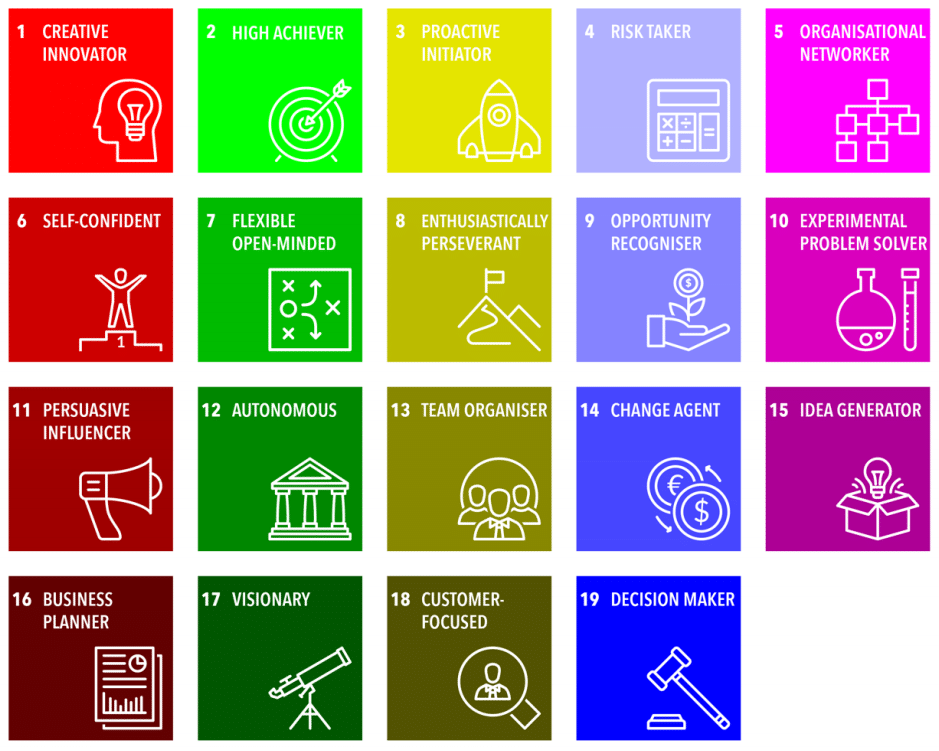Champions, Innovators, Intrapreneurs – What type of personas drive their organisations to adopt innovative methods?
This is the second in a series of blog posts that take a closer look at the special people we work with. We call them champions because they often go to great lengths to innovate within their organisations. After analysing a dozen insightful interviews with our Book Sprints champions (in the first blog post in this series), we now turn to the professional and academic perspective on the characteristics and concepts for these champion personas.
These economists and professionals generously shared their time and knowledge with us: Christian Friedl (Professor at the University of Applied Sciences in Graz), Martina Pumpat (Inhouse Consultant at Ottobock) and Prof. Andreas Eckhardt Professor (Professor at the University of Innsbruck).

Fig. 1: Christian Friedl, Martina Pumpat and Andreas Eckkardt (from left to right)
Finding a frame for the champion persona
Innovators, boundary spanners, bridge builders, champions, bricoleurs – you name them. What they have in common is their ability to filter knowledge from different fields and combine it in completely new ways. But an overarching definition does not exist. The context matters. A champion at a software company is different to a champion in let’s say an automotive related company is different to a champion at a university. (Andreas Eckhard).
There are many terms across academic disciplines and business contexts for the persona we want to understand. A concept that comes close is that of the intrapreneur, coined by Gifford Pinchot in 1985 in his foundational book “Intrapreneuring: Why You Don’t Have to Leave the Corporation to Become an Entrepreneur”. Intrapreneurs are entrepreneurs within an existing organisation. They play a key role in the development of new ideas and opportunities for continuous innovations.
Both [entrepreneurs and intrapreneurs] have many similar characteristics, however intrapreneurs manage to build on existing resources. They can bring innovation and radical ideas through an existing organizational structure and network, which is really a huge achievement when you think of bureaucracy and slow decision-making processes and corporate cultures that you also have to adapt to. (Christian Friedl)

Fig 2: Arthur Fry, inventor of the Post-it Note by Signe Dons
Interestingly for us, Art Fry, the inventor of the post-it notes we use so much in our work, is often used as an example for intrapreneurs. His colleagues at 3M came up with an adhesive that was strong enough to stick to paper and weak enough to not damage it. Fry applied it to a new bookmark, which later turned into a whole new system of sticky notes, tapes and labels, and above all fostered new modes of collaborative work.
What makes an intrapreneur?
Kristian Brøndum Kristiansen from Aalborg University conducted an extensive review and meta analysis of 87 research studies on intrapreneurship in 2019. He found a clear correlation between intrapreneurship and the economic success of companies. However, there are no reliable indicators to identify employees with intrapreneurial potential. For example, some studies looked at companies with top-down intrapreneurship programs that nominated mostly middle management to participate. Although these participants often had a high level of education, many years of project management experience, and knowledge of innovation methods, many dropped out of the intrapreneurship programs. On the other hand, some participants with no innovation history successfully developed new products, services, business models or processes when being promoted.
To help identify these people, Kristiansen developed a holistic concept defining the characteristics of intrapreneurs (depicted in the next image). Many of these roles also came up in our interviews with the experts and champions. We summarize the most salient ones as Visionary, Creative Thinker, Proactive Initiator, Risk Taker and Influencer.

Fig. 3: The 19 intrapreneurial characteristics, Kristiansen (2019)
Visionary
Intrapreneurs are individuals who develop and design novel ideas, products, services or technologies as they have a thriving urge to find better ways of doing things. They recognize that certain solutions might be suitable now, but are not designed for a future to come and constantly question or optimize the status quo.
Creative Innovator
Intrapreneurs are creative people in the sense that they think outside of the box and the system. They are able to see patterns in technological, demographic, and market trends, connect the dots from different knowledge areas and translate ideas, concepts and solutions into new contexts.
Proactive Initiator
Intrapreneurs are opportunistic and ready to act boldly to capture opportunities, even when there is no guarantee of success. Intrapreneurs are not always the inventor, but they are the main implementer of new ideas. They are hardworking individuals with a high internal motivation for results and reaching their goals and they act in an opportunistic way.
Risk Taker
Intrapreneurs are not afraid of taking risks and seeking workarounds to change the status quo. They are driven by problem-solving, overcoming challenges, and resolving dilemmas and ready to use unconventional methods for this. At the same time, they try to reduce the risks through diversification, experimentation and frequent adjusting, making use of their rapid learning abilities.
Team Player
Intrapreneurs are team-oriented and know that intrapreneurship is a team sport. They make use of collaborative methods and tools and have great interpersonal skills to work effectively with others. Furthermore, Intrapreneurs are also team developers; they are self-appointed leaders with the abilities to build effective teams dynamics and unleash capacities.
Influencer
Real intrapreneurs are intrinsically motivated, motivated by values that guide them as well as a kind of optimism. To say yes, we can do it. It’s worth it, despite the risks. Intrapreneurs are persuasive. They can influence others to agree to a new idea or vision for the future. It’s really like an inspiring sparkle – otherwise people would not believe in them and trust that they can really achieve that goal (Martina Pumpat)
After this deep dive into our persona’s profile, we’ll have a look at their challenges and strategies, and what organisations can do to support their activities, in our next blog post.
